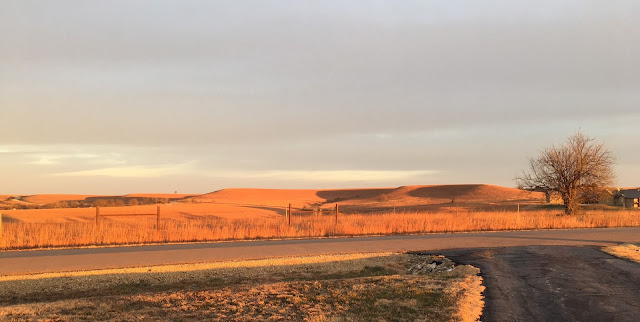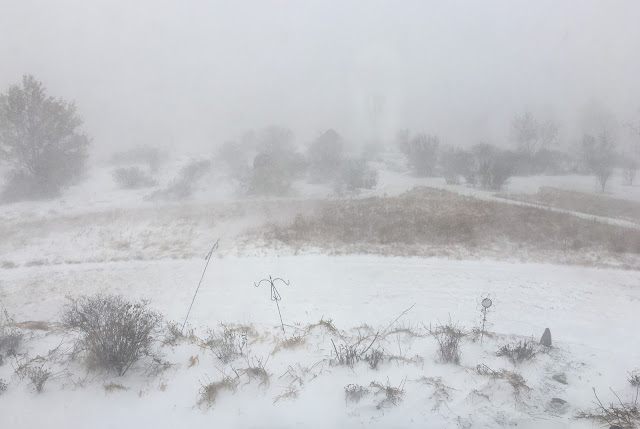ProfessorRoush and his lovely wife, Mrs. ProfessorRoush, were in a Topeka restaurant Saturday evening around 4:15 p.m. when the wind-caused whipping undulations of the umbrellas outside the nearby window captured my attention. Something about their flapping pattern and my years of prairie-honed instincts said "storm", even though the sky out the window was light blue and cloudless.
I did not recall any forecast chance of rain at all and a quick check of the Manhattan weather on our iPhones, 50 miles west of where we sat, showed no chances of precipitation for the evening, but I was still uneasy and a further look at the regional radar showed a thin squall line of strong storms west of Manhattan and bearing down. Quickly estimating the speed of advance and distances involved, we paid our food bill and hastened to the Jeep, in which we proceeded, sometimes slightly above the speed limits, to head with all due haste for home.
.jpg)
A nail-biting and knuckle-white drive commenced. I glanced repeatedly from radar to road as the western sky darkened in the direction I was driving and the increasing winds rocked the Jeep. And I'm happy to shorten your suspense and report that we beat the storm, pulling into our driveway just as large drops began to pummel the windshield. The only one of us, Jeep, driver, or passenger, to suffer the storm was Mrs. ProfessorRoush, who got a quick drenching as she quickly took Bella out to potty before some light hail commenced.
.jpg)
That was it for the time being, 30 minutes of storm and then calmer winds and skies and clear radar from 6 p.m. to 10 p.m. During the night, though, a repeated series of storms formed directly to our west and periodic rain and thunderstorms crossed over us heading to the northeast throughout the night. All that time, the weather apps forecast a lack of precipitation or else, while it was raining, the rain ending soon. The last rain was still falling as I ate breakfast at 7 a.m.
.jpg)
I relate all this not to gain any admiration for my prediction prowess and impressive weather intuition (I self-admired enough at the time), nor to rant again about the constant surprises of Kansas weather, but merely to point out, despite all the advances of modern science, that experts still can't accurately forecast weather an hour ahead, let alone a day, a week, or a hundred years into the future. My head is not in the sand and I don't deny the possibility of climate change, but it's a much longer stretch for me to take on faith 100-year or even next-year forecasts when weather forecasters repeatedly fail on the next hour's weather.
.jpg)
I understand satellite maps and El Niña and El Niño cycles and receding glaciers as well or better than the average educated person, but it takes only a season in Kansas to expose the audacity of anyone who thinks they have all the variables of climate accounted for, the solar cycles and the CO2 levels and the effects of increasing expanses of pavement and population bombs and pandemics. Millions of predictions can be instantly dispatched by the next unpredicted volcanic eruption which can alternatively either throw up enough dust to shade the planet or expel enough CO2 to shame the entire output of the industrial revolution.
.jpg)
I swear I am not prone to jumping onto every conspiracy. In fact, I'm not quick to jump on any wagon at all until I'm certain the axles will hold. Too many old, rickety, hay wagons have been under my butt in my past life as a farm boy to not remember the bruises. My words today will not please some of my readers, but I'm bone-tired of experts who can't say "I don't know." Whether it's COVID spacing or climate change or the dangers of avian influenza, human hubris holds us back from the real truth. Those in authority should learn to say these important words and mean them; "I don't know, but we'll keep looking." It's okay to admit uncertainty and we can all handle the truth better than adamant speculations that are ultimately wrong. And even dangerous.
.jpg)
I believe in science, the real science where you can freely question anything and seek truth through experimentation and gain knowledge through experience. But I'll believe the climate and weather predictions when they can beat the marrow-held instincts of the dirt- and wind-sniffing farm boy.
(Some may be asking, what does all this have to do with the daylilies pictured here? And the answer is: "Nothing. They are just pretty pictures to keep you calm and happy." Which makes me just one more person who can't say "I don't know. but it seemed like a good explanation at the time.")
Rant over....now back to your regular programming. I hope, as someone just told me, you could hear the smile in my voice" while I ranted.
.jpg)
.jpg)
.jpg)
.jpg)
.jpg)
.jpg)
.jpg)
.jpg)

















